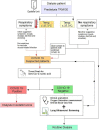Lung ultrasound may help in the differential diagnosis of suspected oligosymptomatic COVID-19 patients on hemodialysis: A case report
- PMID: 34164903
- PMCID: PMC8444644
- DOI: 10.1111/hdi.12958
Lung ultrasound may help in the differential diagnosis of suspected oligosymptomatic COVID-19 patients on hemodialysis: A case report
Abstract
Introduction: Considering that patients on dialysis showed a poor outcome during COVID-19 pandemic, and that COVID-19 symptoms in dialysis patients are often mild or absent, each dialysis unit should implement local strategies to early recognize patients affected by COVID-19. However, many available SARS-CoV-2 diagnostic tests demonstrated a moderate sensitivity, 70%-80% is probably a reasonable estimate. Consequently, having useful tools for differential diagnosis becomes essential. In this scenario, lung ultrasound (LUS) may have an important role in the evaluation of lung involvement in hemodialysis patients during COVID-19 pandemic.
Methods: We present two cases of hemodialysis patients with COVID-19 pneumonia in whom LUS had a central role in the diagnostic process. Ultrasound images of COVID-19 pneumonia show a typical bilateral pattern characterized by multiple or confluent B-lines with spared areas, thickened and irregular pleural line, and rare subpleural consolidations. LUS showed high accuracy in diagnosing COVID-19 pneumonia.
Findings: Despite both patients appeared clinically euvolemic and afebrile, they presented with acute diarrhea and oxygen saturation level of 92%-93%. Although clinical manifestations were mild and not specific in both patients, LUS raised suspicion on the possible COVID-19 diagnosis which was confirmed by a positive nasopharyngeal RT-PCR.
Discussion: There are many reasons for a patient on dialysis to present shortness of breath, fever, and multiple B-lines at LUS assessment (such as heart failure, fluid overload, vascular access infection, interstitial pneumonia) but the recognition of typical ultrasound patterns of the COVID-19 pneumonia is helpful for differential diagnosis. LUS may have an important role in the screening process of hemodialysis patients during the COVID-19 pandemic, especially in oligosymptomatic patients before the SARS-CoV-2 diagnostic tests, and in those with suspected symptoms and/or known exposure with unexpected negative SARS-CoV-2 diagnostic tests.
Keywords: COVID-19; SARS-CoV-2; dialysis; lung ultrasound.
© 2021 International Society for Hemodialysis.
Conflict of interest statement
The authors have declared that no conflict of interest exists.
Figures



Similar articles
-
Lung Ultrasound May Support Diagnosis and Monitoring of COVID-19 Pneumonia.Ultrasound Med Biol. 2020 Nov;46(11):2908-2917. doi: 10.1016/j.ultrasmedbio.2020.07.018. Epub 2020 Jul 20. Ultrasound Med Biol. 2020. PMID: 32807570 Free PMC article. Review.
-
Lung Ultrasound in COVID-19 Pneumonia: Correlations with Chest CT on Hospital admission.Respiration. 2020;99(7):617-624. doi: 10.1159/000509223. Epub 2020 Jun 22. Respiration. 2020. PMID: 32570265 Free PMC article.
-
Correlation between Chest Computed Tomography and Lung Ultrasonography in Patients with Coronavirus Disease 2019 (COVID-19).Ultrasound Med Biol. 2020 Nov;46(11):2918-2926. doi: 10.1016/j.ultrasmedbio.2020.07.003. Epub 2020 Jul 13. Ultrasound Med Biol. 2020. PMID: 32771222 Free PMC article.
-
Applicability of lung ultrasound in the assessment of COVID-19 pneumonia: Diagnostic accuracy and clinical correlations.Respir Investig. 2022 Nov;60(6):762-771. doi: 10.1016/j.resinv.2022.06.015. Epub 2022 Aug 8. Respir Investig. 2022. PMID: 35995704 Free PMC article.
-
Thoracic imaging tests for the diagnosis of COVID-19.Cochrane Database Syst Rev. 2020 Sep 30;9:CD013639. doi: 10.1002/14651858.CD013639.pub2. Cochrane Database Syst Rev. 2020. Update in: Cochrane Database Syst Rev. 2020 Nov 26;11:CD013639. doi: 10.1002/14651858.CD013639.pub3. PMID: 32997361 Updated.
Cited by
-
Lung ultrasonography performed by nephrologist: COVID-19 as an opportunity to reveal ultrasound's full potential and usefulness in the dialysis room.Clin Kidney J. 2022 Dec 16;16(3):541-548. doi: 10.1093/ckj/sfac250. eCollection 2023 Mar. Clin Kidney J. 2022. PMID: 36865007 Free PMC article.
-
Analysis of Experiences in Preventing COVID-19 in Hemodialysis Centers of the North of Poland before the Era of Vaccination.Int J Environ Res Public Health. 2022 Jan 7;19(2):684. doi: 10.3390/ijerph19020684. Int J Environ Res Public Health. 2022. PMID: 35055503 Free PMC article.
References
-
- Woloshin S, Patel N, Kesselheim AS. False negative tests for SARS‐CoV‐2 infection ‐ challenges and implications. N Engl J Med. 2020;383:e38. - PubMed
Publication types
MeSH terms
LinkOut - more resources
Full Text Sources
Medical
Miscellaneous

